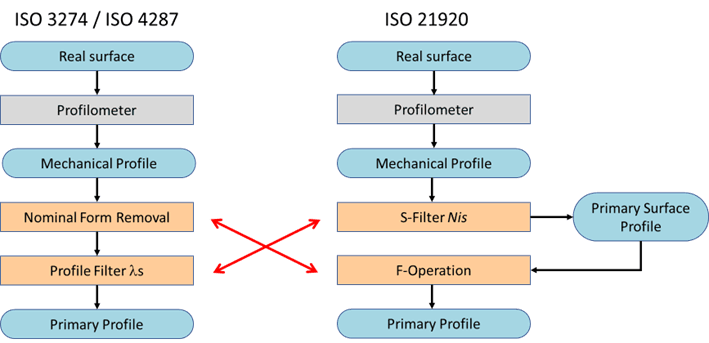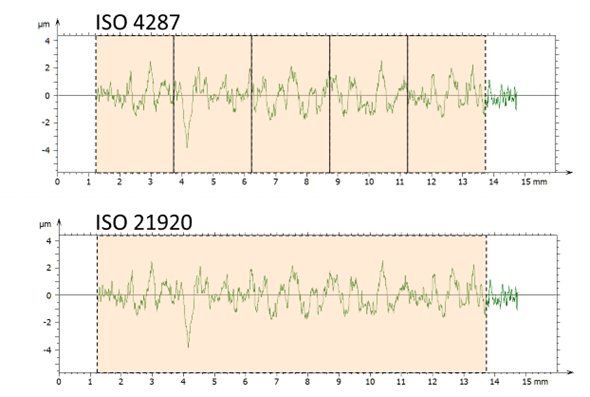Until recently, profile parameters were defined in three international standards: ISO 4287 (main parameters), ISO 13565 (Rk parameters) and ISO 12085 (R&W motif parameters). 25 years after their implementation, it was time to modernize, correct and extend these standards. This was the aim of ISO 21920, a standard in three parts published in Dec 2021. François Blateyron, senior surface metrology expert at Digital Surf and member of ISO Technical Committee 213, describes the main changes.
Are the former standards still valid?
The new ISO 21920 standard officially replaces ISO 1302, ISO 4287, ISO 4288, ISO 13565-2 and -3 which were withdrawn at the end of 2021. However, existing specifications made on technical drawings published before the new standards are still valid and bound to the former standards. Specifications made on new drawings may refer to either the new standard or the former standards. This is possible by adopting the new “root symbol” defined in ISO 21920-1, meaning that parameters are defined in ISO 21920-2 and decision rules are described in ISO 21920-3, or keep the existing symbol defined in ISO 1302, which means that parameters are defined in ISO 4287 or ISO 13565, and decision rules are described in ISO 4288.

Above. A new root symbol is introduced by the new standard.
Although the former standards can still be used, they are no longer official international standards and are considered as obsolete with respect to current industry practices. It is expected that the switch to the new standard will take several years, but ISO 21920 will become the dominant standard.
Are the parameter values the same?
Most ISO 4287 parameters are still included in ISO 21920-2. Designers and metrologists will still be able to specify tolerances on Ra or Rz or Rsk. However, their definition in the new standard is slightly different so it may create different results.
Reason 1: different operation workflow
The first important change concerns the order of some operations. In ISO 4287, the primary profile is obtained after a nominal form removal followed by a lambda S filter. In ISO 21920-2, these operations are reversed, in order to be aligned with standard practice for surfaces. In the end, the disparity in results will be small, but for some profiles, especially those that contain form, the parameters may show significant differences. Procedures will have to take this into account when verifying specifications based on ISO 21920.
Reason 2: definition on the evaluation length instead of the sampling length
The second major change concerns the definition of parameters that are no longer averaged over sampling lengths. In ISO 4287, parameters were estimated on each sampling length (5 by default) and the final value was indeed the average of these estimators. The aim of this procedure was to stabilize results when measured by workshop profilometers, in production. Now, this precaution is no longer needed and only one value is calculated over the evaluation length. The only exception is for parameters related to peaks and pits (Rp, Rv, Rz) that are still calculated on section lengths to avoid unstable results.
Be prepared to cope with parameter differences
When compared on the same profiles, the two standards show satisfactory correlations on most parameters, but some parameters are more sensitive to the changes and will give different results on the same profiles. It will be necessary, for industrial users, to evaluate the impact on their workpieces and potentially update the tolerance limits on their technical drawings. However, this should not discourage users to adopt the new standard.

Above. Modified workflow with inversion of the S-Filter and F-Operation.

Above. Parameters are now defined on the evaluation length and no longer averaged.

Above. Differences depend on the parameter and on the profile: Rq values are virtually unaffected whereas differences in Rsk can be more significant.
Welcome to the future
Despite potential parameter differences, the new standard is better suited to modern product specifications. Besides the differences on existing parameters, the new standard also introduces new parameters that are highly adapted to modern engineered surfaces.
It is the responsibility of designers and metrologists to update their knowledge and understanding of the new standard.
Surface texture specifications cannot be limited to Ra and ISO 21920 offers a wide range of parameters adapted to the surfaces of the 21st century.
MountainsMap® 9.3 software, as well as partner packages based on it, includes the ISO 21920 standard as well as the former ones.
Author : François Blateyron
Resources :
A deeper look at ISO 21920, in our Surface Metrology Guide: guide.digitalsurf.revelateur.fr/en/guide-iso-21920-parameters.html